The driverless future is being created now. About the “Dronnitsa-2023” rally
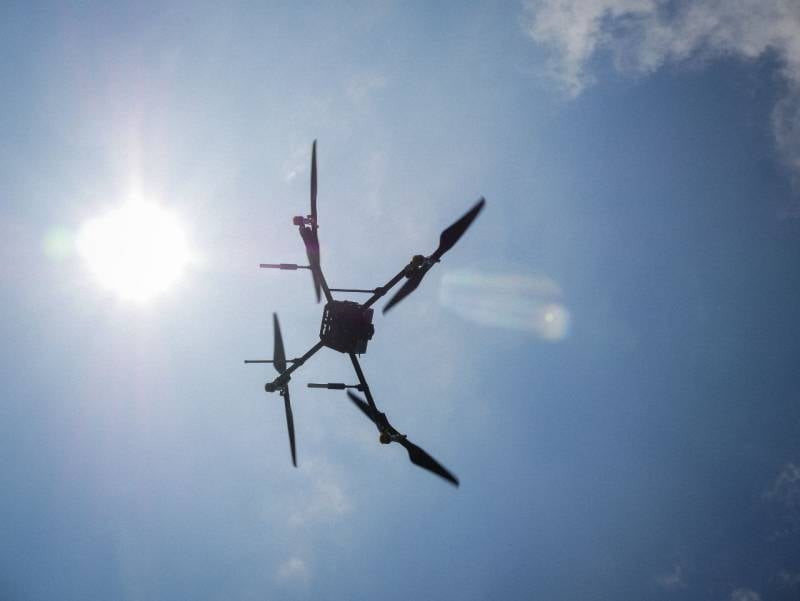
Will Russia break through to a bright unmanned future? This experimental Russian copter of an original design gives hope. And not only him. Photo: KCPN
More than a month has passed since the end of the organized Coordination center for assistance to Novorossiya - KCPN — the “Dronnitsa-2023” rally, which is still defined as a gathering of operators of combat unmanned aerial vehicles, but in fact it has long outgrown such status.
Of course, an overview of what happened should have been given earlier, but better late than never, especially since in a slightly distant retrospective some things are seen differently.
Brief background
Maxim Klimov best wrote about the series of conferences and events of the KCPN, united by a common “brand” (the most correct definition) “Dronnitsa” in an article with a long title “The conferences of the Coordination Center for Assistance to Novorossiya “Dronnitsa” are an unconditional success in a “very problematic field”.
It’s not worth retelling the excellent article, the main thing that can be taken from it is that “Dronnitsa”, which began as a gathering for the exchange of experience among copter operators, has become much more - a series of events that are actually moving forward the entire unmanned subject in Russia - and the training of operators for the front, and the dissemination of combat experience, and information about what the enemy is doing, and what is on telegram channel "Dronnitsy" called the words “People's Military-Industrial Complex”.
In 2023, “Dronnitsa” was held, as for the first time, in Veliky Novgorod, on August 25 and 26, and the last day, with closed displays of equipment, was held at an airfield near Demyansk.
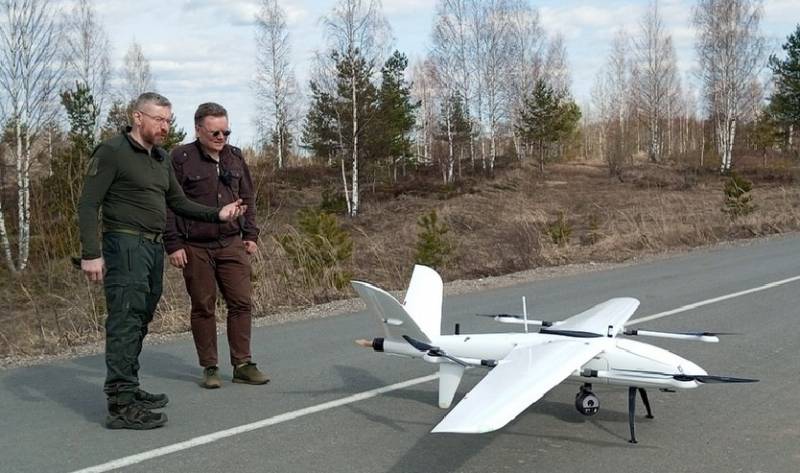
The fathers of "Dronnitsa" - Alexander Lyubimov (left) and Alexey Chadayev (right) next to the "rising star" of aerial reconnaissance - the Ajax V400 UAV. Photo: KCPN
Several previous events gave special significance to Dronnitsa 2023.
Firstly, starting next year in Russia it will launch National project for the development of unmanned aircraft systems (UAS). This will be a very ambitious project: for the first time since the 60s of the last century, it is planned to create nothing more or less than an entire industry in our country. And the KCPN, in the course of a number of events (not all of them can be talked about), was noted in the preparation of a number of concepts for this national project, moreover, immediately before “Dronnitsa-2023”.
Secondly, over the period that has passed since the last “Dronnitsa”, both domestic developers of small UAVs, and software developers for them, and component developers have made a considerable step forward for such a short time, and the last “Dronnitsa-2023” became for these teams great look. Looking ahead, there was something to show these people.
For an example of the pace at which the domestic “drone theme” is moving, it is worth citing the article "Victory Quadcopters", written by the author in January of this year. Half of the wishes from it in general, and in terms of software - all of them - have not only come true, KCPN and other volunteer groups have done much more than was listed there - and not even a year has passed.
Although it is too early to rejoice, and this will also be discussed below.
Thirdly, the holding of “Dronnitsa-2023” was influenced by purely military factors - on August 19, 2023, in Chernigov, Ukraine, a Russian missile, presumably of the Iskander complex, hit the building of the drama theater, where a similar Ukrainian event dedicated to aerial reconnaissance and drones.
At the same time, also on August 19, a blow was struck at the Soltsy airfield, located 78 kilometers (by road, 72 km in a straight line) from Veliky Novgorod, where Dronnitsa-2023 was supposed to take place. The Ministry of Defense acknowledged the fact of the strike and that the Tu-22M3 bomber was damaged. Immediately after the attack, photos of a burning bomber that fell on the fuselage and rumors that a Ukrainian sabotage group was operating in the area spread on social networks. However, there were other reports about the way the Ukrainian side obtained the airfield.
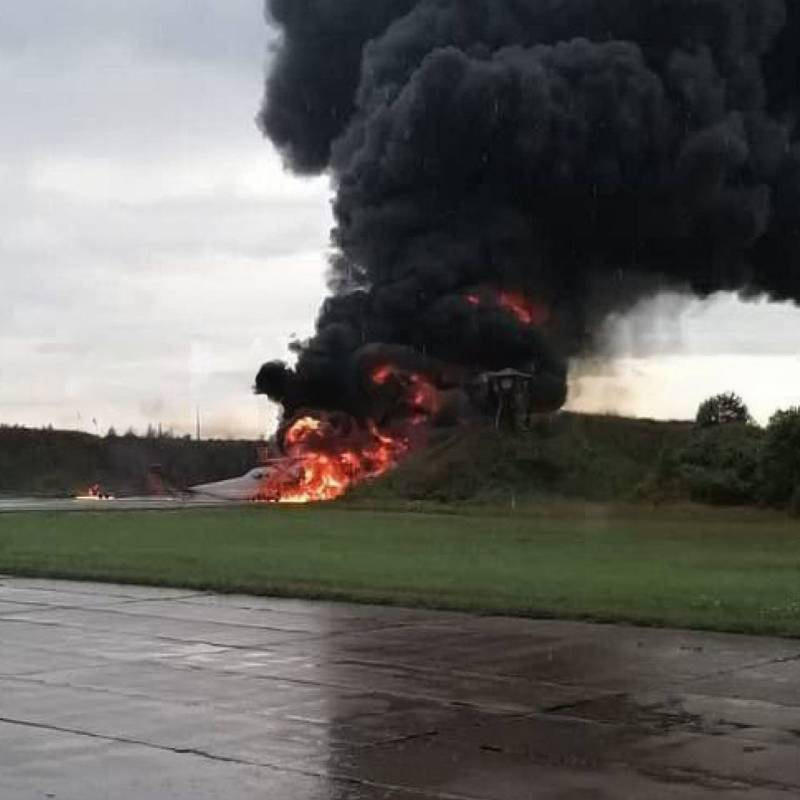
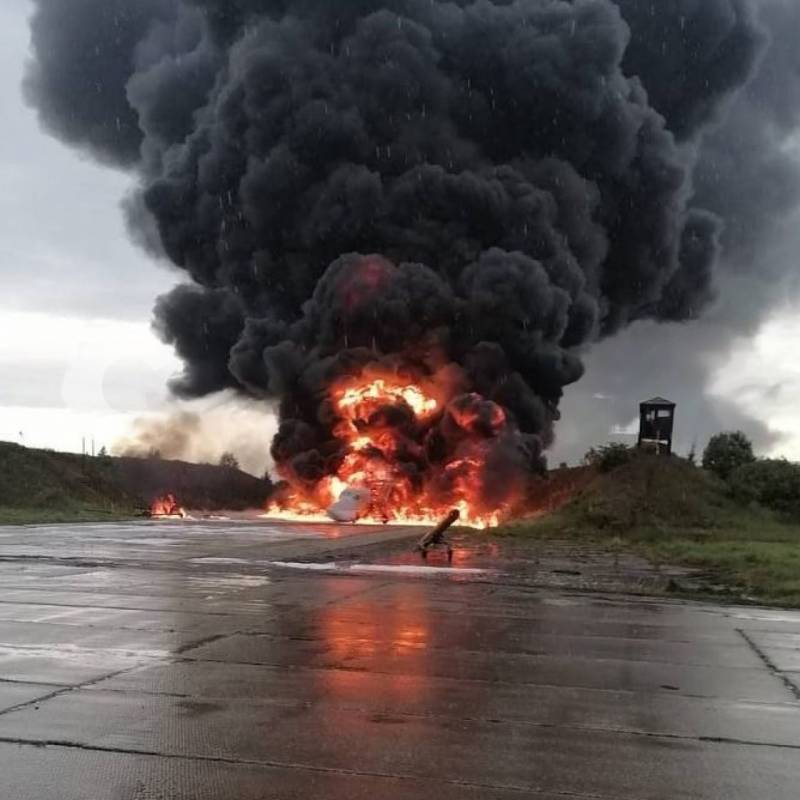
Tu-22M3 is on fire, August 19, 2023, as stated in the source - Soltsy airfield. This event made us pay more attention to safety than usual. Photo: Telegram channel “Military Informant”
The combination of the fact that such a Ukrainian event received a missile and was disrupted with losses, the technical ability of the Ukrainian side to attack the target in the place where the event took place, and the importance of the volunteer movement for the Armed Forces (and in fact we would have already lost the war, if it weren’t for volunteer copters, not for supplies that the Ministry of Defense itself does not supply, including even vehicles, not for instructors and not for training courses organized by civil activists and organizations, one of which, and apparently one of the most powerful among which is the CCPN) , suggested that the “opponents” might try to make a return “visit.”
Which required serious security measures during the event, for example, in terms of electronic reconnaissance and countermeasures.
Everything worked out, and the enemy was unable to interfere with the event.
Theory
Organizationally, the first day and a half of “Dronnitsa-2023” consisted of lectures on issues related to the combat use of unmanned aerial vehicles, which covered a wide range of issues on the topic. For example, the issue of possible organizational and staffing structures of strike units of an unmanned aerial vehicle is of great importance. aviation. And at Dronnitsa-2023, the former commander of the Guards Motorized Rifle Brigade with extensive combat experience, Colonel P. A. Biryukov, made a report on the OHS of a company of attack drones.
The organization of such units is of particular importance, and to explain why this is so, we need to digress for a moment.
Until recently, the prevailing thesis was (and many still believe so) that a “drone” is just another commander’s tool for reconnaissance and sometimes a targeted strike.
But practice is already beginning to show that this is not so.
For example, a copter in the air and well-functioning closed communications, together with a quick response from the command to intelligence requests, make it possible, only using standard means, to create conditions for the enemy that preclude his survival.
For example, a vehicle can fire a 120-mm mortar against an enemy reconnaissance group, but if it has passed the zone in which it can hit it, then the AGS crew located somewhere else can be switched to it; you can calculate the time required for a quick maneuver of a fire group with some group unit weapons, which will be able to hit this vehicle at a certain calculated point, while simultaneously providing the command post with a picture of the situation around it.
Several dozen heavy copters, capable of lifting one or two 82-mm mortar mines (7 kg each), are superior to a mortar battery in their ability to harm the enemy due to the fact that they hit the target from the first release. They can also quickly place guided mines directly in front of a moving enemy column, deliver television cameras or seismic sensors, or lift into the air a repeater for FPV strikes.drones, place an engineering charge on a protected armored cap or other similar structure, spray smoke or aerosols in the air for camouflage, deliver water and ammunition to the surrounded firing point (which has happened more than once) - and all these possibilities are in the hands of the company commander.
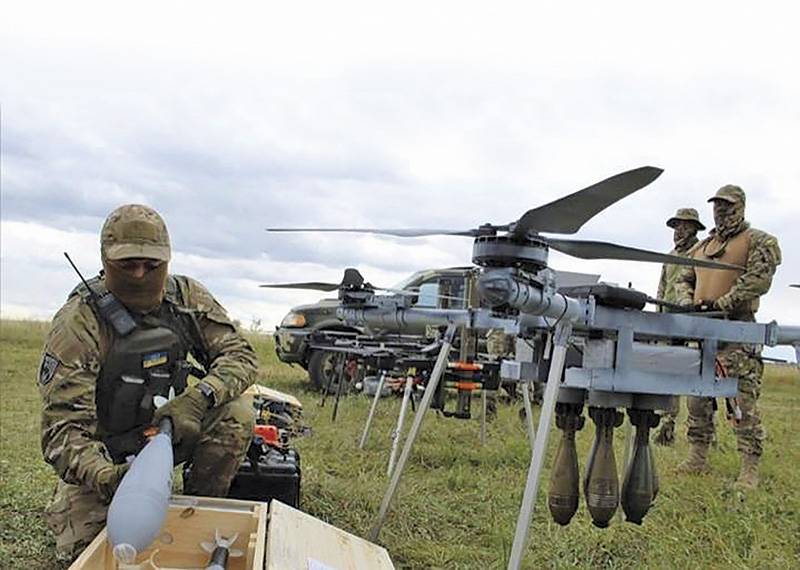
UAV shock companies have long been formed in the Ukrainian Armed Forces and, unfortunately, fight very successfully. In the photo - preparing a Ukrainian copter for a combat mission
At the moment, it is becoming obvious that with the proper introduction of unmanned and unmanned systems into the Armed Forces, they will change the appearance of armies in the same way as motorization and the transition from horses to cars and Tanks.
The results of a closed event to determine the shape of unmanned systems of the future and how they will change society say the same thing.
This issue was discussed in more detail by the head of the KCPS Alexander Lyubimov and Alexey Chadayev in their joint lecture, available on video.
One of the tasks of the CCPN, in addition to helping the fighting army, is to ensure that Russia does not fall behind in this race, and even better, takes the lead in it.
And therefore, the formation of experimental units and subunits with UAVs as the main strike weapon is a pressing and urgent task. Companies, uniformly organized, equipped and armed, are the basis for training combined arms commanders in the fundamentals and tactics of using UAVs in combat.
The report on the attack UAV company, read at Dronnitsa, shows how to move from theory to practice, and with serial and commercially available equipment.
Not all information should be disclosed, but you can quote those excerpts from the report of P. A. Biryukov, which were published by the KCPS itself on the telegram channel dedicated to “Dronnitsa-2023”:
The enemy is already moving past the organizational stage of unmanned control in his army. We are just experimenting in this matter for now. This needs to change.
It is necessary to build normal UAV military units. A UAV company could become such a unit.
The simplest UAV company is a highly mobile unit, capable of acting both to reinforce other units and independently. It must be highly mobile, using pickup trucks as transport. Main armament: medium-lift quadcopters with airdrop. Such a unit, in terms of functionality, is closest to the anti-tank fighter regiments of the Second World War. With the forces of such a company, it will be possible to ensure tactical superiority in an area of 2 km.
The advantage of a UAV company is the ability to use it in a dispersed manner. Without concentration lines, company columns, without capacious ammunition replenishment points. This way we remove the main points of vulnerability.”
24 UAVs with strike modules in one flight can drop 576 VOG-17 or VOG-25 or 48 82-mm mines, from 24 to 48 shaped charges on the enemy.
For a motorized rifle company this is “nothing,” but a UAV company, due to the peculiarities of using this ammunition, will pay for itself in 2 days of combat use.
And most importantly, with such a unit, any officer will be able to make a normal decision for battle (which is now unrealistic). Now, when officially there are no quadcopters in nature, the RAV service cannot even issue a BC properly.”
As you can see, domestic specialists have an understanding of where to move, and this is an urgent issue. Unfortunately, although conceptually military thought in Russia is ahead of that in Ukraine, in terms of the practical implementation of some things, the Armed Forces of Ukraine are leading, and also at the expense of units that grew out of civilian volunteers.
This, of course, will not save them in the future, but we need to accelerate faster, and the theoretical grounds for such acceleration at Dronnitsa-2023 were both formulated and voiced.
There were other valuable and interesting materials from completely different speakers - anti-UAV specialists and a number of other experts. Thus, a fighter from the BARS-13 “Associate Professor” detachment made a qualitative overview of what you need to know and be able to do when organizing the use of copters as part of combined arms units, up to the organization of an unmanned aerial reconnaissance platoon. Well-known military expert Maxim Klimov made a good analysis of the capabilities that unmanned aircraft provide when preparing to break through enemy defenses. Evgeniy Khrisanfov, an instructor on the use of unmanned aircraft, raised the issue of combining different methods for detecting drones. KCPN instructors, who regularly work with the troops and therefore remain anonymous, read a very interesting and important report on how to prepare civilian copters for war. Professor of the Air Force Academy, Doctor of Technical Sciences Alexander Ananyev outlined how military science sees the problem of assessing the effectiveness of the use of small-class attack UAVs, with experimental data and the mathematical apparatus necessary to carry out such assessments.
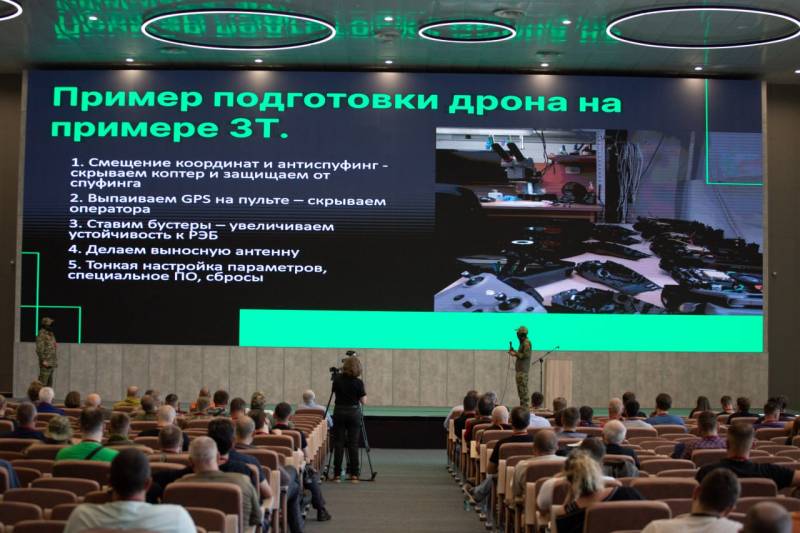
There is a report on the preparation of civilian drones for combat use. Photo: KCPN
Of particular importance was the now traditional part—the analysis of mistakes and failures. Gorky stories from the participants in the battles in Donbass before the start of the Northern Military District and from those who fought during the Northern Military District, contained very useful and costly experience that cannot and should not be lost.
People's military-industrial complex
While specialists and experts spoke and guests listened, an extensive exhibition was held in parallel, dedicated mainly to unmanned aerial vehicles and their components.
In a way, it was a review of what domestic engineering teams and small companies have achieved so far.
In addition to aircraft already ready for use, mock-ups of products that are just being created were exhibited.
There were also very interesting devices, for example, a small fighter copter LIS (Flying Fighter System), attacking an enemy copter using a grid.
There is nothing innovative in such an attack scheme, and the copter was more of a model - a demonstrator, rather than a finished product ready for use, but the nuance is important - with this device the operator does not participate in either detecting the target or in its attack: a drone operating on trained algorithms, identifies and attacks the target independently.
While the scheme still needs work, for example, it uses components from unfriendly countries.
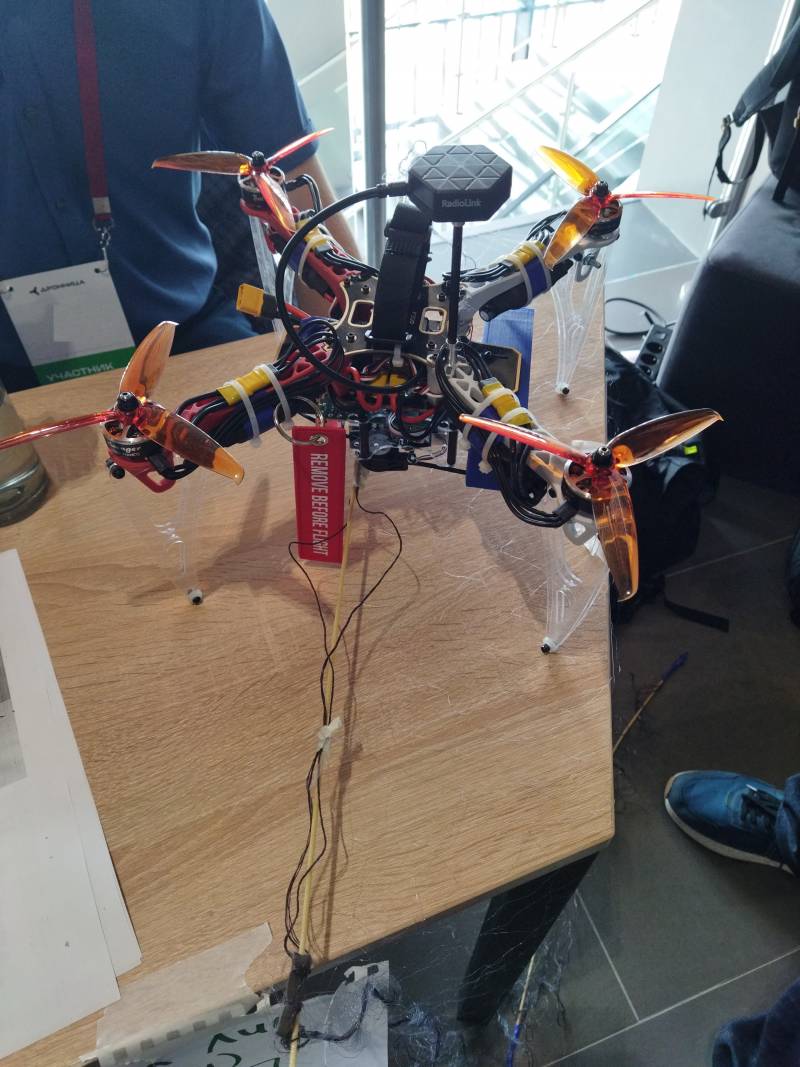
Looks like a toy, but it's the future. Photo by the author
Or another example - a reconnaissance strike vertically taking off UAV with wings, carrying two strike FPV drones on an external sling.
The crew of such a UAV has much greater freedom of action than just a reconnaissance aircraft - if the target is maneuverable and moves quickly, if there is an understanding that it will not be possible to direct artillery fire at it, then you can destroy it with your own means - kamikaze drones. Well, or, at least, hit, disrupt the enemy’s combat mission, immobilize it so that the artillery can then finish off this unit, and so on. This product has already flown and detached FPV drones in the air.
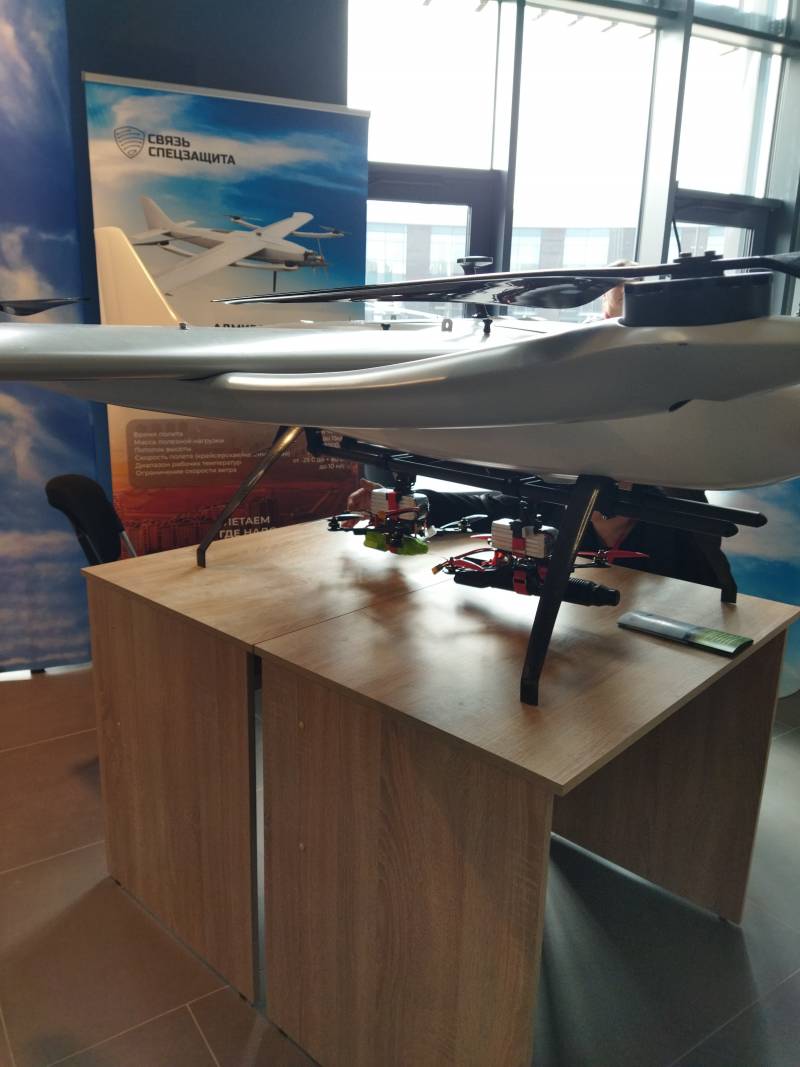
An aircraft-type UAV is a carrier of attack FPV drones. Photo by the author
In general, dozens of samples of small drones were presented at the exhibition, including those with a very original design, and we can say that the domestic school of designing and creating drones has taken place.
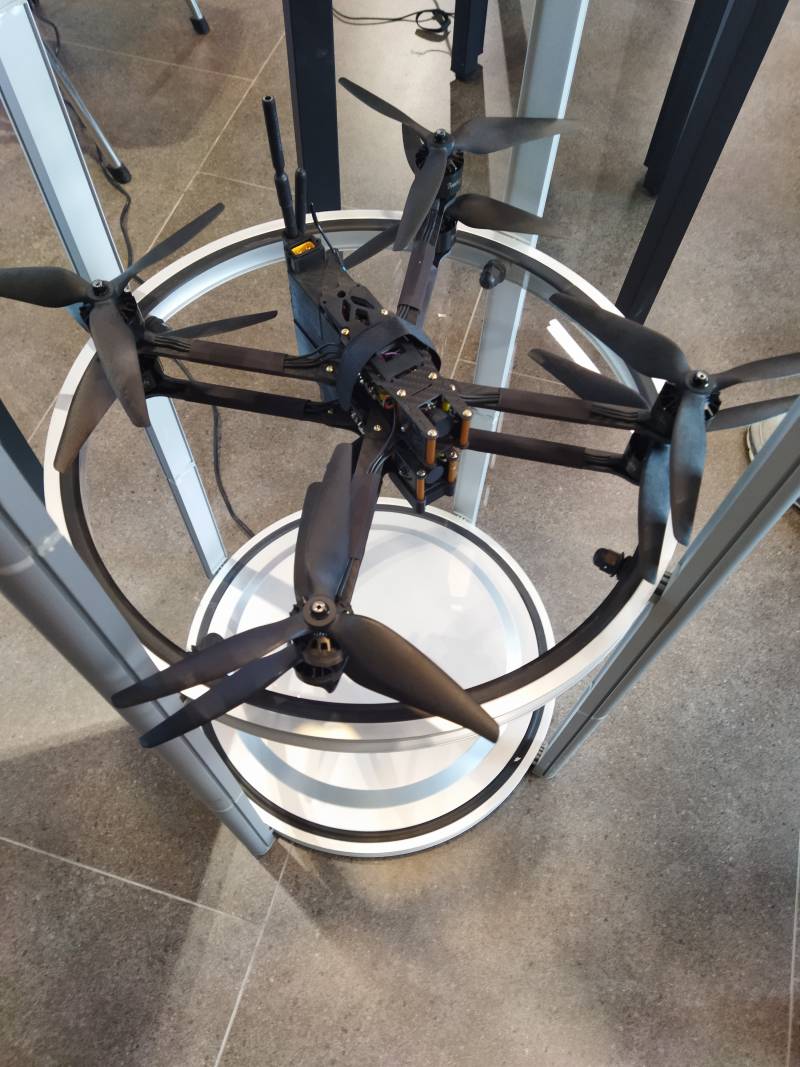
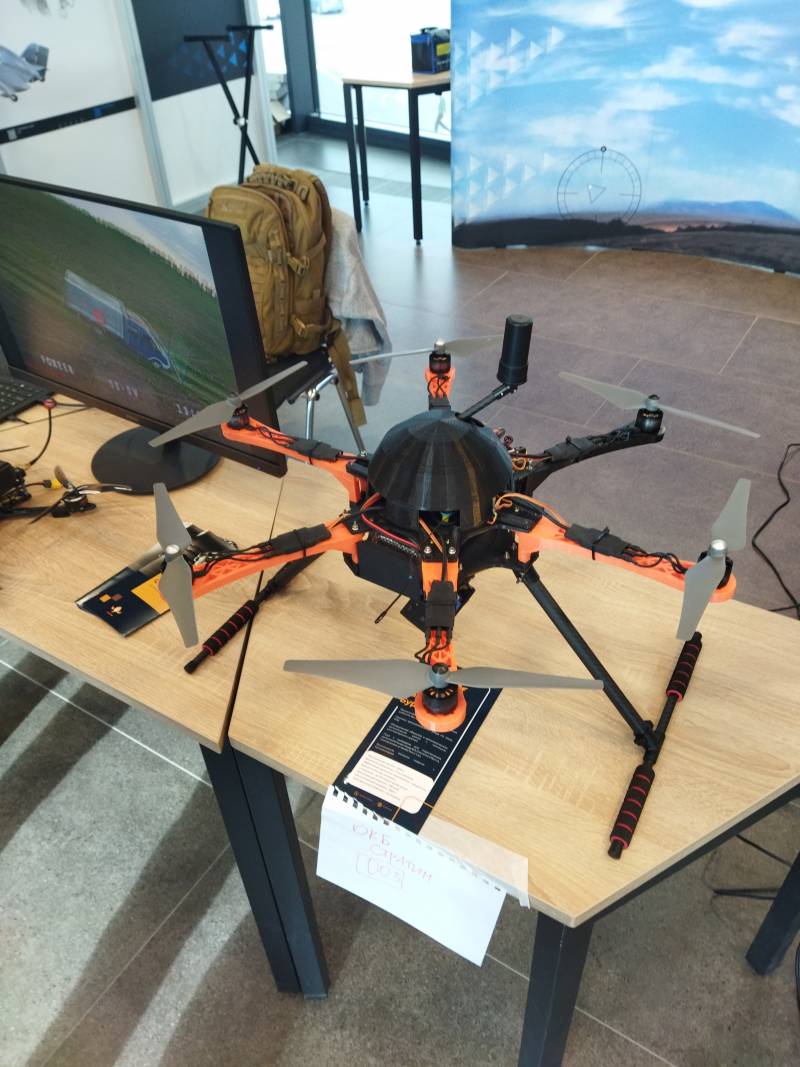
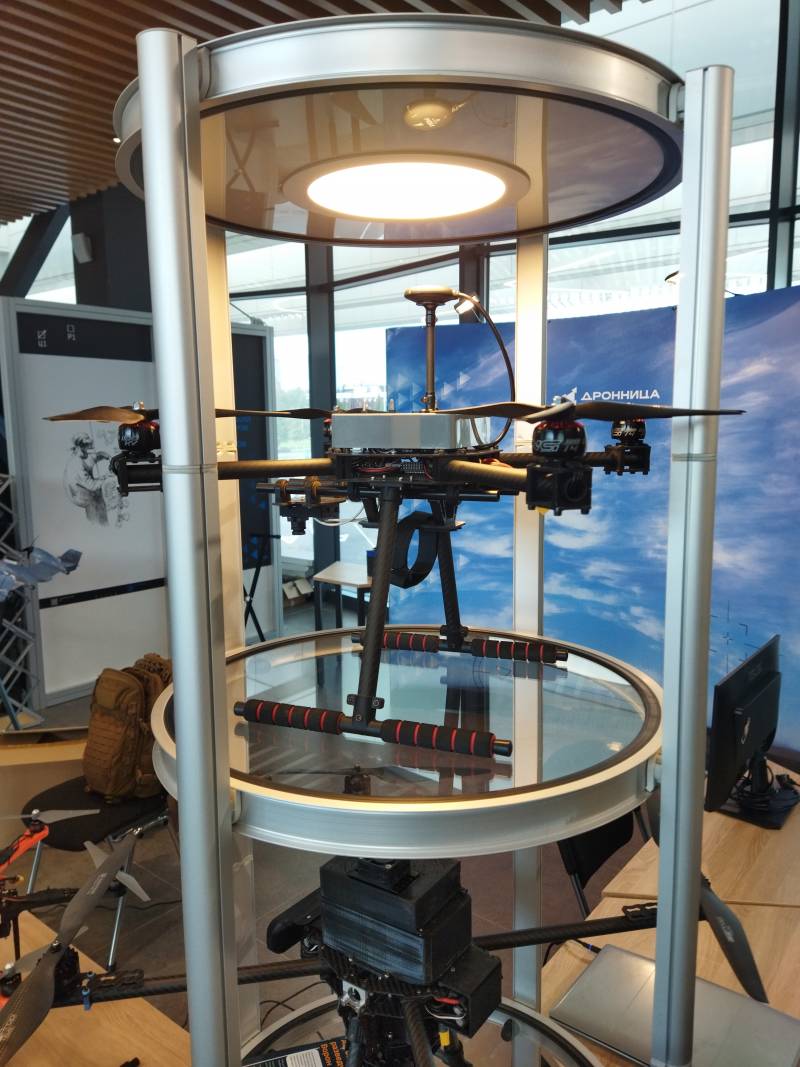
Photo by the author
The question, however, is about components - almost nothing necessary is produced in Russia, and for what is produced, there are often no materials.
In general, if we talk about components for UAVs, almost all of them are imported.
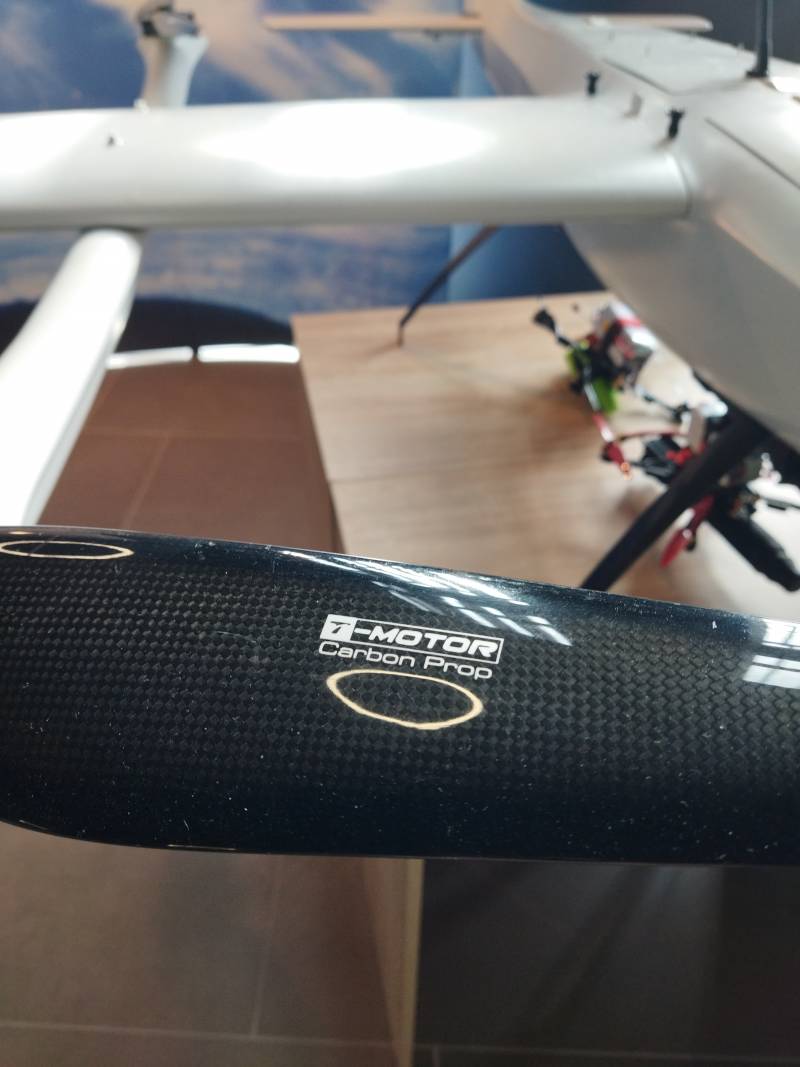
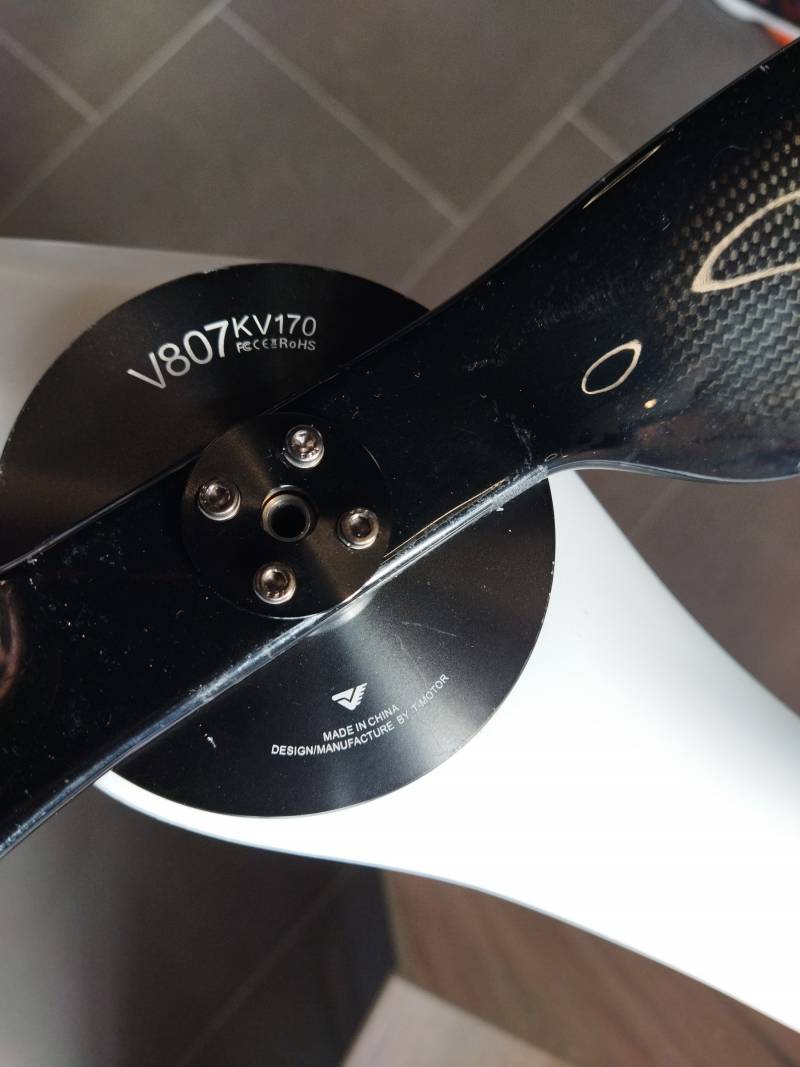
Chinese propellers, Chinese electric motors... that's the only way for now. Photo by the author
There is some progress here, too, but a serious breakthrough can be achieved only when the above-mentioned government program starts working, and, taking into account Russian realities, if it works. For now, let's hope for the best.
However, component developers were also present. Veliky Novgorod is one of the centers of domestic electronics, and this area is developing here, work in the field of artificial intelligence is developing. A Novgorod manufacturer of electronic components was also here - OKB "Planet".
We were pleased with the suppliers of stabilized rotary turrets, a small piston engine with domestic markings, and a design bureau engaged in the development of electric motors for drones. But all these are still experimental samples.
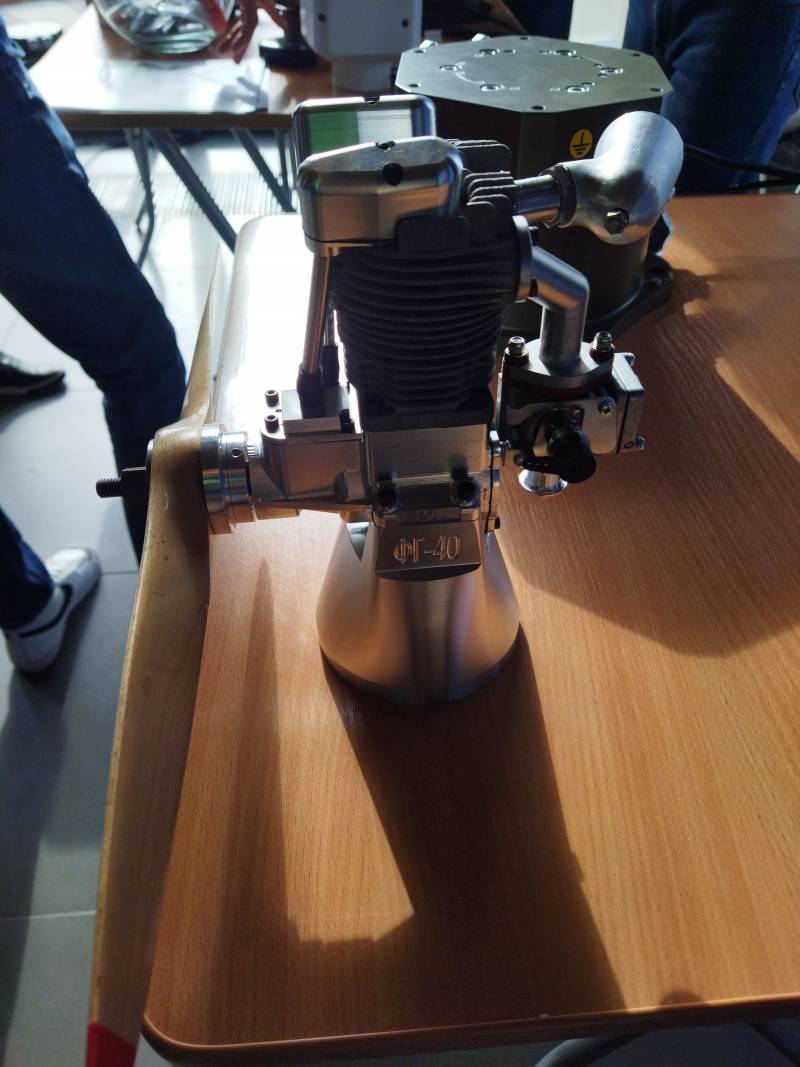
Experimental domestic aircraft engine FG-40. Photo by the author
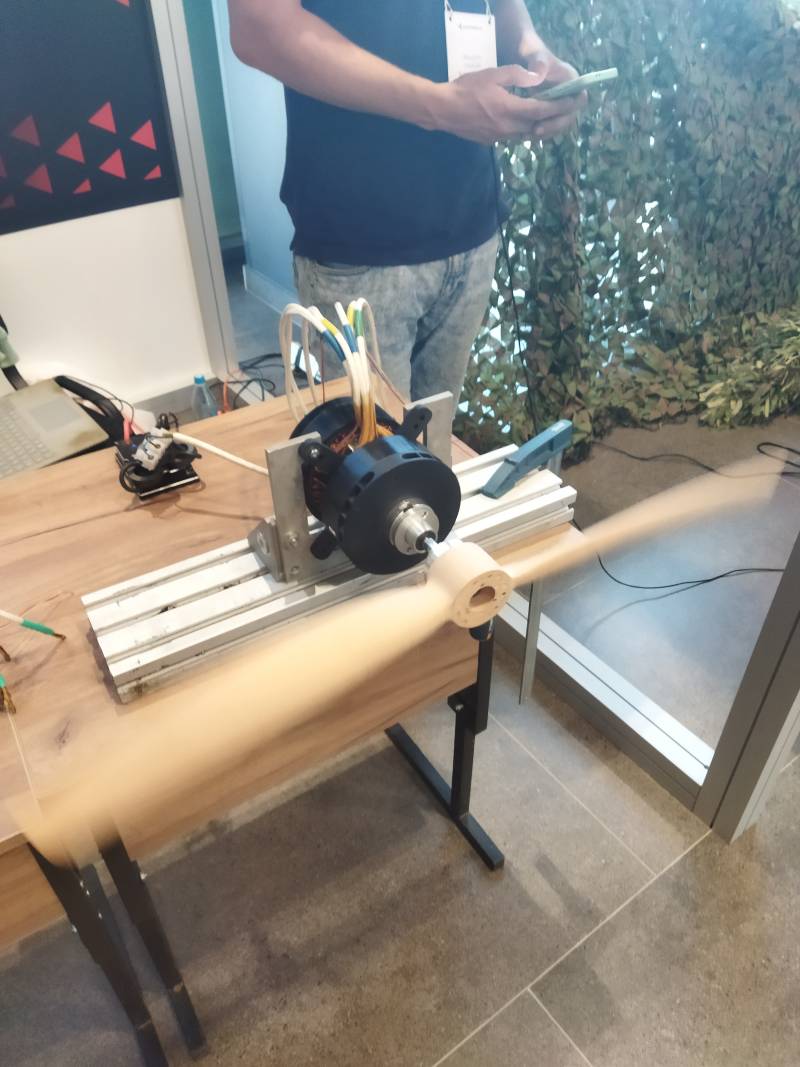
Experimental electric motor for UAVs. Photo by the author
In addition, supplies for the front produced and supplied by volunteer organizations and small firms were widely represented.
Trench stoves, sapper cats, capes for camouflage from thermal imagers, individual equipment.
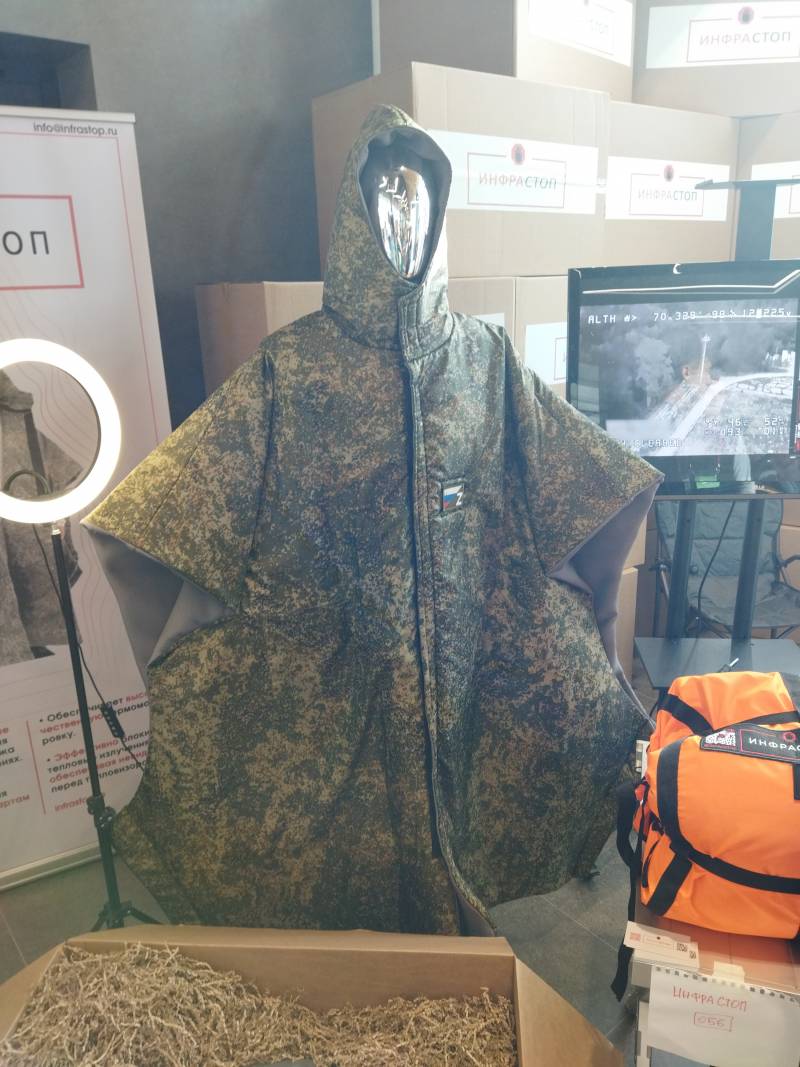
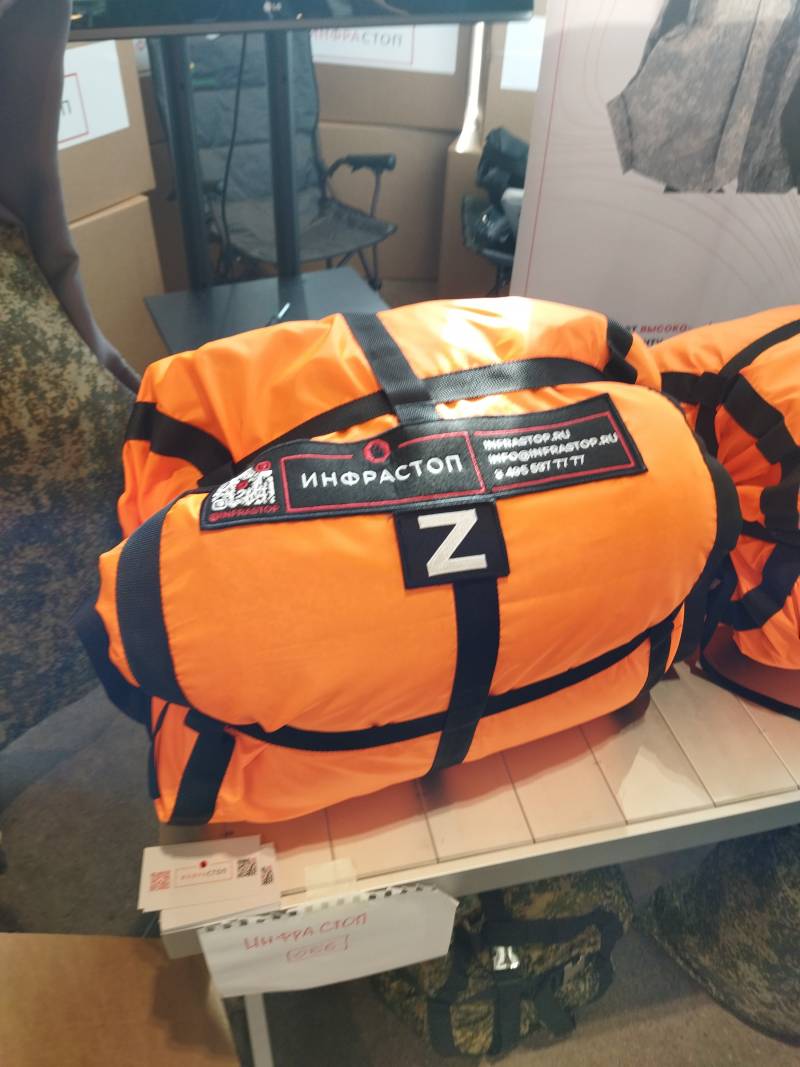
Protective cape for thermal imaging and carrying bag. Photo by the author
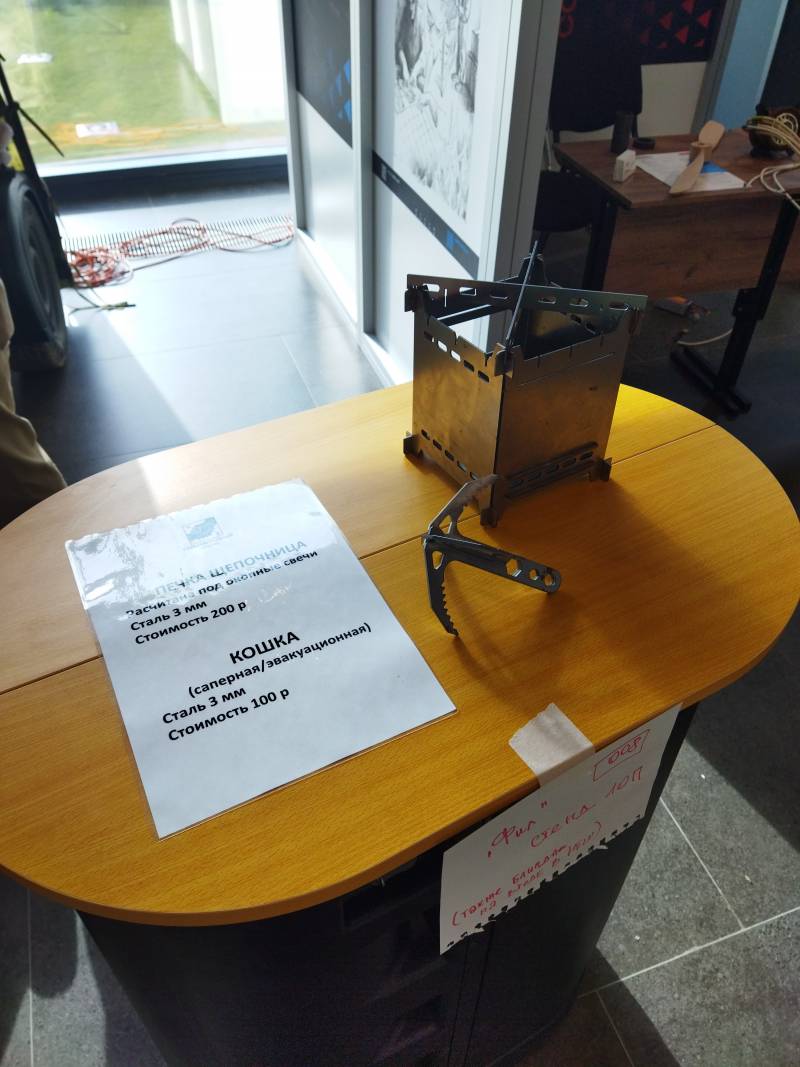
Sapper cat and portable stove. These products are supplied to the troops by volunteers from the “Support Group of the Armed Forces of the Russian Federation and Donbass” from St. Petersburg. Photo by the author
Of interest were specialized vehicles, for example, completely silent all-wheel drive (motor wheels in front and rear) electric motorcycles developed by the Horizon Design Bureau from Tambov, designed for secretive and fast movement off roads along the front line. Such a vehicle is suitable, for example, for doctors or UAV operators. The design is intentionally simplified, this is not an engineering mistake, this solution was born during testing. At low speeds, vehicles have a large (up to 80 km) range.
There were also electric transport trolleys.
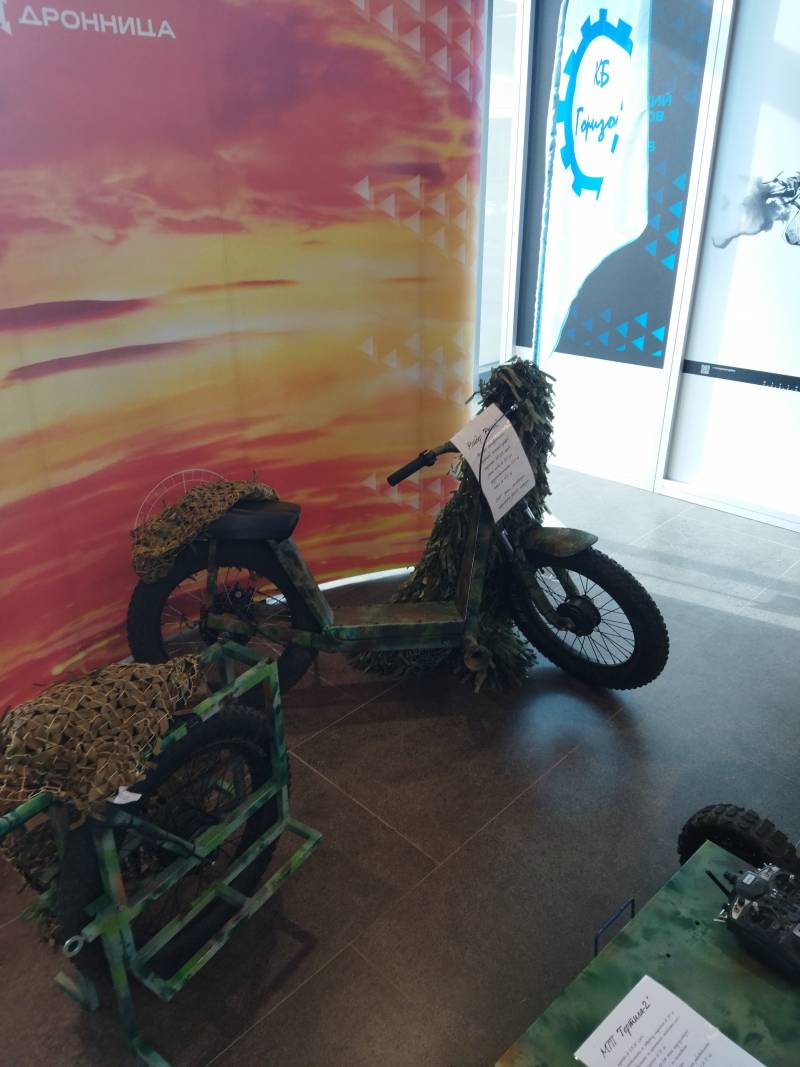
Electric motorcycle from KB "Horizon" from Tambov. The simplicity of the suspension design is not an engineering mistake; it turned out to be better according to the test results. Electric motors in both wheels provide high maneuverability. Photo by the author
Volunteer Sergei Shaposhnikov, a member of the “Victory Technologies” group, presented the “Pioneer” tracked transporter, made entirely of domestic components.
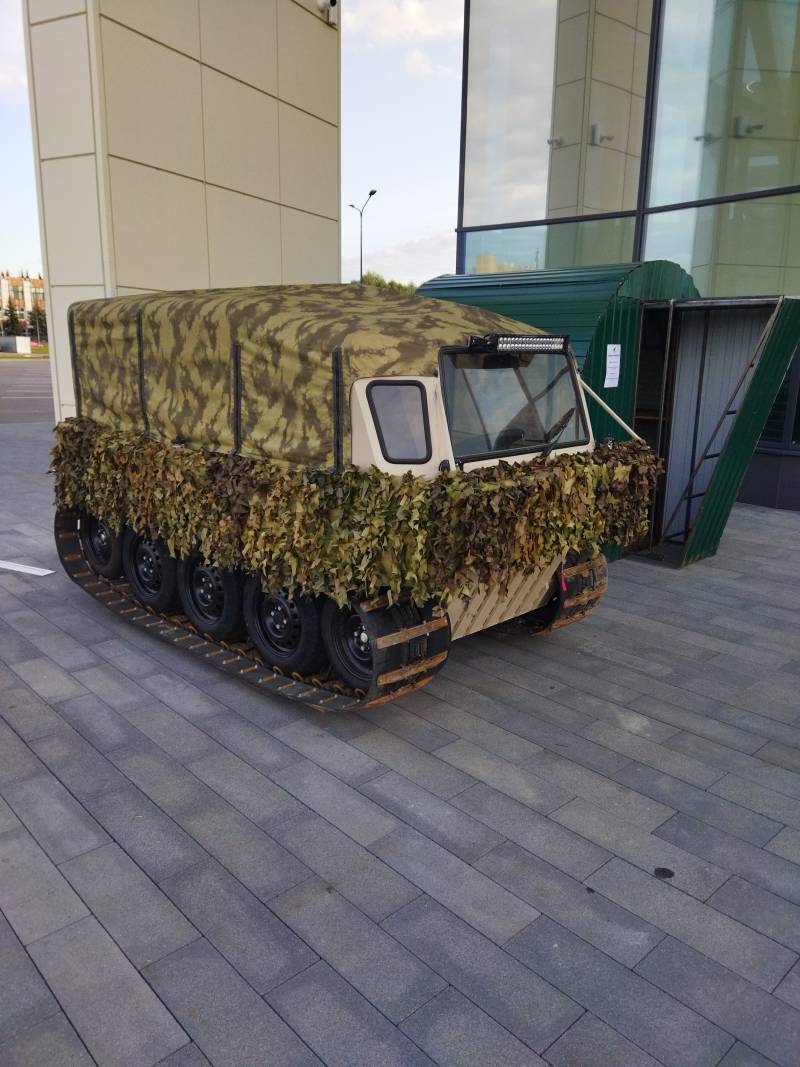
Photo by the author
Such a machine could in the future become the basis for a future front-line conveyor, although it must be admitted that the caterpillar track for such a machine is not optimal, and the height with the superstructure is too high.
The KCPN stand was remembered for its special, extremely scarce tactical literature, which is in great demand and respect at the front, and modernization kits for domestic small arms produced in the old years - from the Mosin rifle to Kalashnikov assault rifles of various modifications.
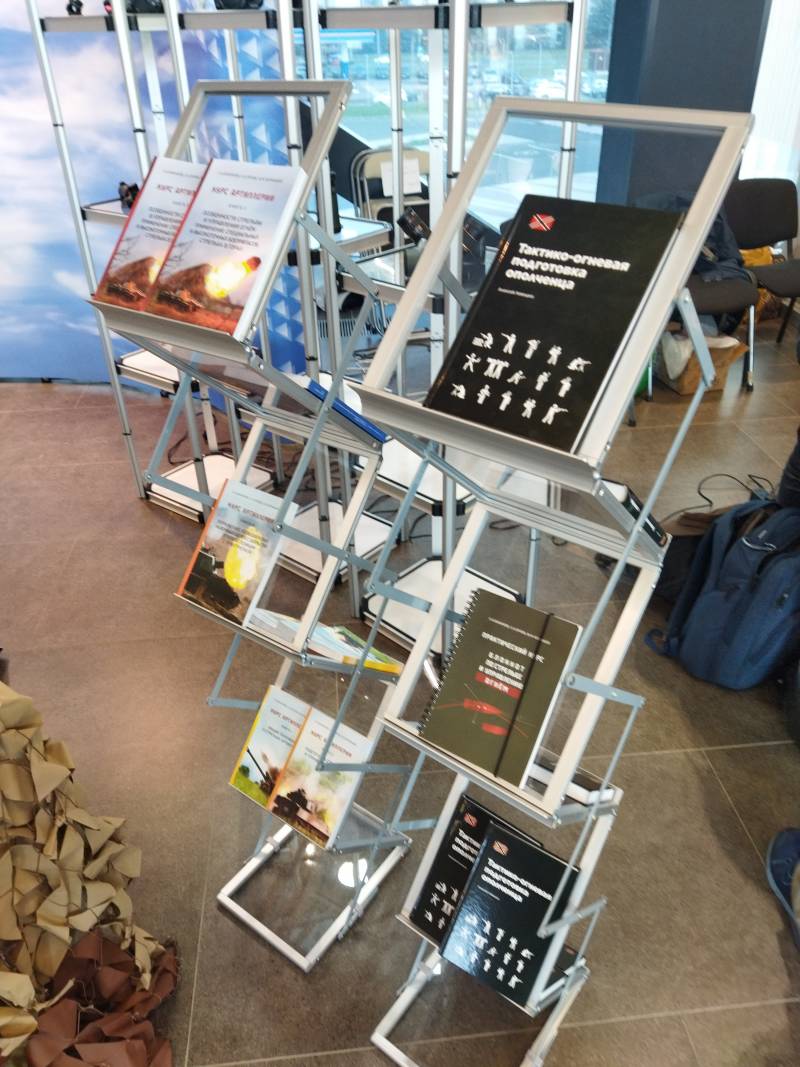
KCPN literature on tactical training. Photo by the author
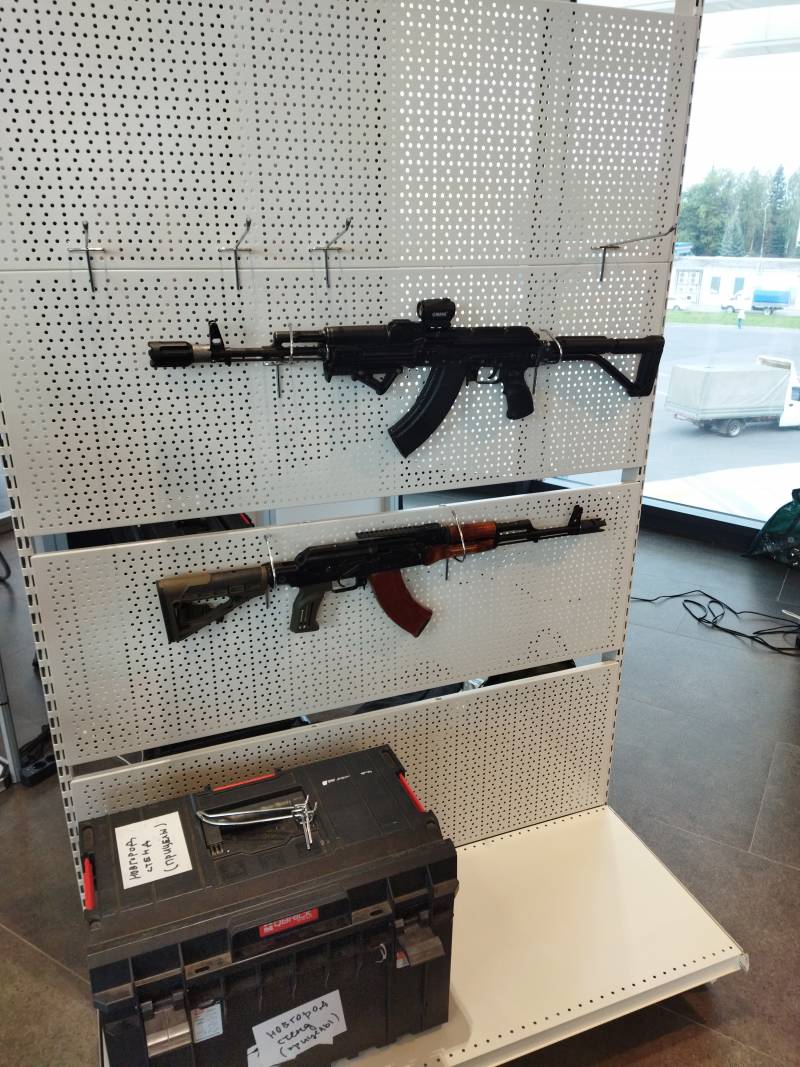
Retrofit kits for Kalashnikov assault rifles. Photo by the author
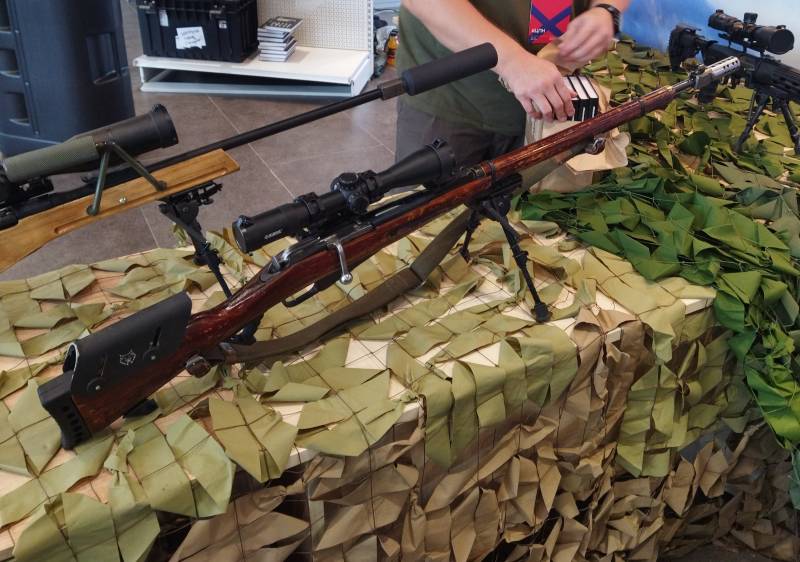
Mosin rifle retrofit kit. Photo by the author
Particularly worth mentioning are the manufacturers of camouflage networks - especially the volunteer movement “People's Network”, organized by Vladimir Grubnik, a former underground fighter from Odessa, and now the leader of several large-scale volunteer projects to provide troops with digital radio communications and vehicles not provided for by the organizational structures of units and units. “People's Network” massively supplies troops with such an important item of supply as mask networks, made in full compliance with all standards and without restrictions suitable for military use.
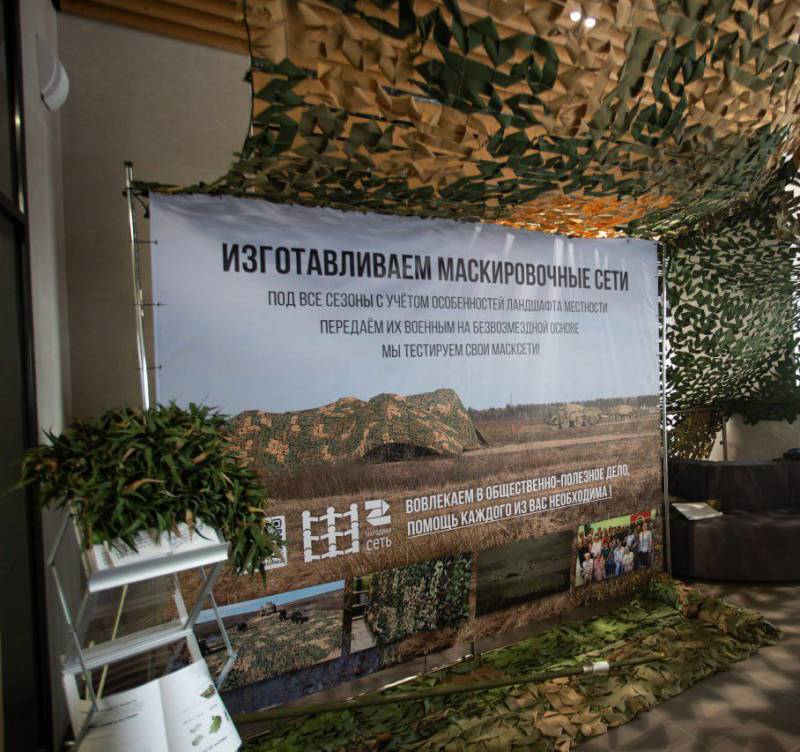
Stand of the People's Network. Photo: KCPN
The format of the article does not allow us to cover everything, talk about all the exhibits and participants, but it is worth stating that Russian civil society is fully established, and it is an important and significant factor in our future victory. After all, a significant part of everything shown was made even without an eye for commercial use.
But this was not the main thing at Dronnitsa-2023.
Flights and tasks
For half a day on August 26, the groups and companies participating in the rally showed off their drones in action, and suppliers, developers and manufacturers of electronic reconnaissance equipment practiced pinpointing control channels.
At the same time, camouflage networks were tested: the task of the KCPN UAV operator was to detect objects that were covered by them. It must be said that the vast experience in aerial reconnaissance made itself felt immediately, and it was impossible to hide from the view from above.
At the same time, invited musicians, singers and artists entertained the assembled audience, as if there was no war, but with a certain flavor - before the start of the “airfield” part of the “Dronnitsa” in Borki, the head of the KCPN Alexander Lyubimov warned everyone that a drone strike from the Ukrainian DRG was possible, which, by the way, was never found, and explained where to run when the alarm sounded. The instructors of the control center, who at that moment turned into a unit ensuring the security of the event, monitored the appearance of “alien” signals from the control channel in order to immediately suppress them if necessary.
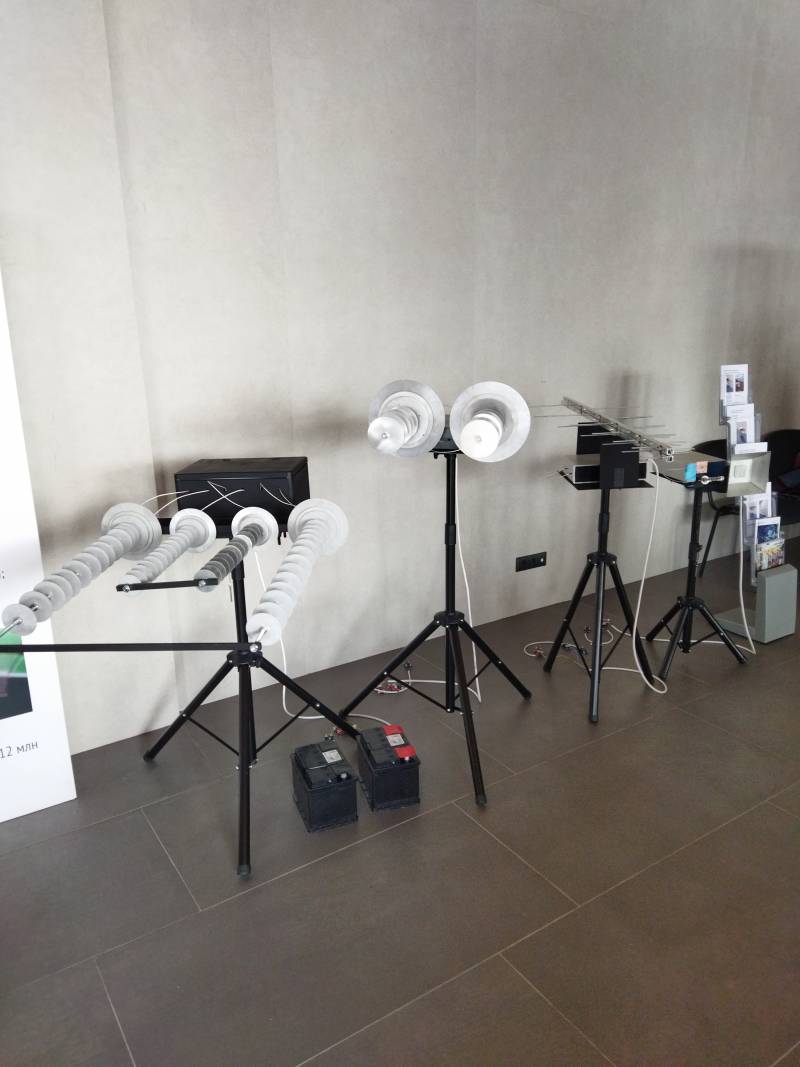
Antenna systems of electronic warfare systems at Dronnitsa. Photo by the author
It must be said that the people among the visitors were cool-headed, and some even discussed how the Ukrainians could carry out the attack.
But the attack never happened.
However, the flights at the airfield in Borki, which took place on August 26, were only a prelude to the real work, which started a day later, in the forests near Demyansk, at the newly revived small airfield.
Here it is worth returning to the article by M. Klimov mentioned at the beginning and quoting a fragment from it:
We wish them success in the implementation of ideas and work!
And it must be said, even if not on a scale comparable to American or Russian military exercises, the job was done - to the extent that a non-governmental non-profit organization can do it.
In the forests near Demyansk, a strong point was set up simulating enemy positions. And then the drone developers showed their “birds” in conditions where the target and jamming environment to some extent corresponded to the combat one.
One after another, “drones” of different teams entered the combat area, with the task of finding a Ukrainian opornik and a camouflaged mock-up gun.
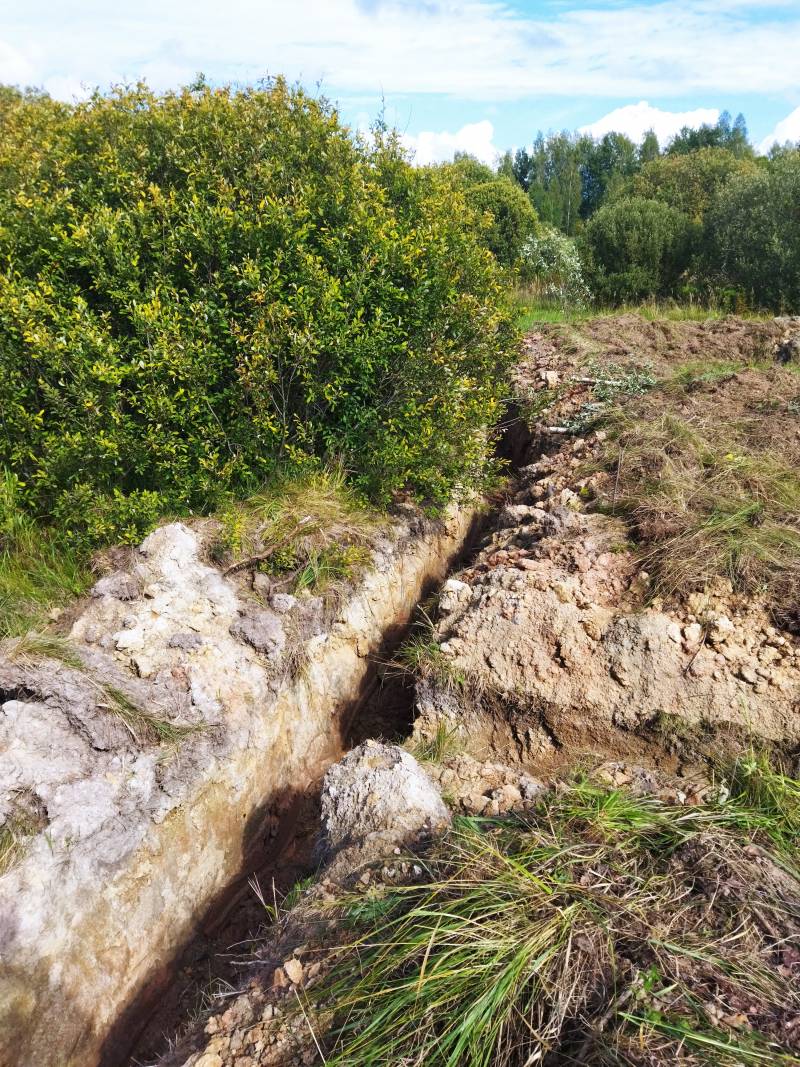
At a conditional enemy stronghold. Photo by the author
And on the ground, other teams with electronic reconnaissance and electronic suppression systems were supposed to detect the operation of the control channel and suppress these frequencies.
It’s not worth revealing all the details of what is happening here, let’s just say - the experiment turned out to be important, useful, successful and yet quite large-scale - the flights took half a day, and whoever flew there - from the team of one of the design bureaus with a heavy attack copter of their own making, capable of going into area of combat use autonomously (the guys flew from a closed area, based on the results of their participation in the North Military District, Ukraine gives a million hryvnia for them), up to that very VTOL carrying kamikaze attack drones on an external sling.
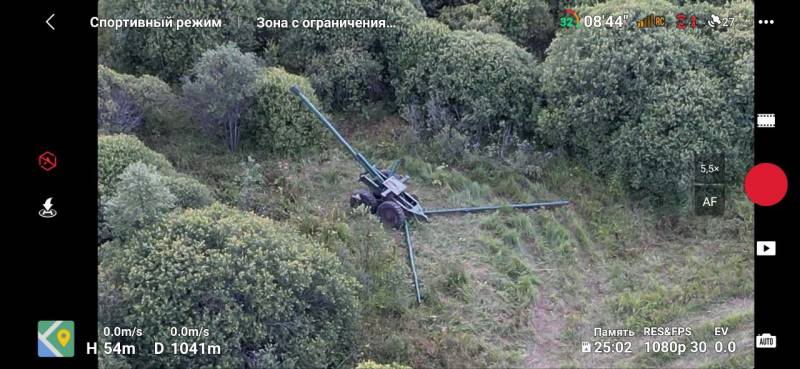
Model of the 2A36 "Gyacinth-B" gun. Photo: “Prickly”
Visual control of the exercises was carried out from the “rock star” of this event - a vertically taking off unmanned aircraft "Ajax V400" with a multispectral optical-electronic surveillance system, including a 45x camera and a thermal imager.
The appearance of this aircraft and the special attention of the KCPN to such UAVs is natural and has long roots.
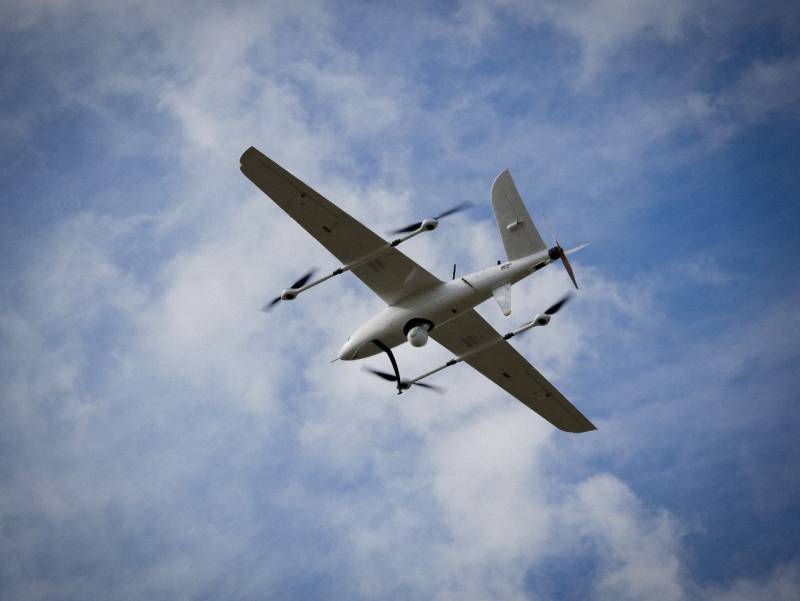
UAV "Ajax V400" in flight. Photo: KCPN
The organization has long been puzzled by the supply to the troops and the combat use of not only copters of various types, but also winged vehicles that have a long flight range and make it possible to provide reconnaissance and target designation for any Russian artillery system over the entire range of its actual fire, and not during a flight to range limit, there and immediately back, and with some reserve of time for loitering and reconnaissance of the target.
And the Ajax reflects precisely this desire - it does not replace copters, which will now remain in the army forever, but it does the same thing as the mass-produced Orlans and other winged vehicles in service.
But, unlike them, the Ajax does not need a launch catapult and does not land by parachute - it takes off and lands vertically on its own, and can be launched not only from an open area and taken to it, but if urgently necessary, from a destroyed building, from a ship, and even from the back of a truck, although the latter will then be extremely difficult to land on.
The range is less than that of the Orlan, but again, it does not replace it, but rather complements it, and volunteers cannot give Orlans to the troops where they are lacking, and the Ajaxes can easily get into the troops in this way they can.
As befits military drones, Ajax allows the crew to obtain the coordinates of the observed object in the SK-42 coordinate system, which is used in the Armed Forces.
In addition to a vertically taking off aircraft, the Ajax Technologies Design Bureau also presented a quadcopter. However, it is simply impossible to talk about all the flying innovations of the Dronnitsa in one article.
Challenges for the future
Largely thanks to KCPN, the unmanned aerial vehicle industry in Russia is moving at a rapid pace. However, this is not a reason to relax, as has already been said, the Armed Forces of Ukraine are still leading on some things.
This is, for example, the use of heavy copters for strike tasks - they are inferior to disposable loitering ammunition of the Lancet type in terms of range, but they are reusable, very difficult to shoot down and have a low attack cost, since standard mortar mines or grenade launcher shots are used as ammunition.
The second thing that the Ukrainian Armed Forces are currently conducting is analytical work to combat our UAV operators, “copter pilots,” for which resources and forces that are simply unimaginable for Russian commanders have been deployed.
This needs to be countered, but we need to move forward in other directions.
In the closed part of the event, the senior instructor of the KCPN on the use of copters voiced what training for UAVs should look like at the moment.
It is no longer enough to teach UAV calculations and provide them with equipment. It is necessary to teach the officers who will command these crews to correctly assign tasks to them.
For example, vertical wing operators cannot be positioned as close to the front as copter operators; they are more visible, and the UAV needs a safe space in which to gain altitude.
It is necessary to organize the dissemination of important technical information about the enemy and the new products he uses among the troops. Because if it gets into counterintelligence, it will be classified, and if it doesn’t, it will simply disappear in the unit that got it, but it needs to be quickly communicated to the troops, and in this matter, secrecy is often less important than the speed of bringing information to users .
We need reliable algorithms of action that allow us to solve such issues correctly and without improvisation.
And, as it was said in the report of P. A. Biryukov (and before that many times non-publicly, including by A. Lyubimov), it is necessary to begin to form strike units on drones, capable of operating with a large mass of aircraft, as the Armed Forces of Ukraine do.
Much more is needed, there is a difficult struggle ahead, and it is not a fact that it will not affect each of us.
KCPN remains at the forefront of this struggle, and the Dronnitsa rallies remain both a review of achievements and a way to formulate the tasks of tomorrow.
Information